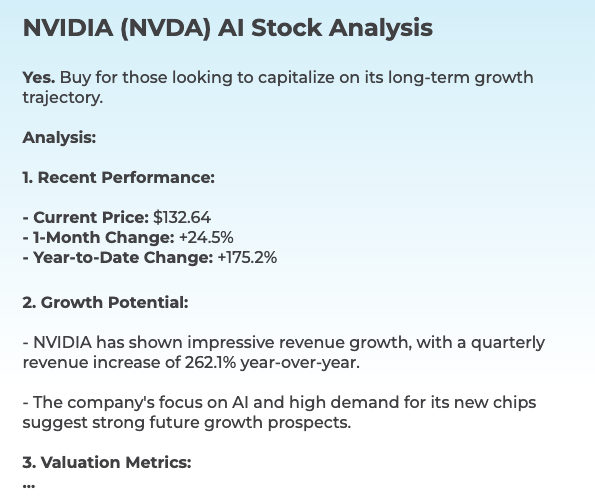20 Top Ways For Choosing AI Stock Prediction Websites
20 Top Ways For Choosing AI Stock Prediction Websites
Blog Article
Top 10 Tips To Evaluate The Ai And Machine Learning Models Of Ai Platform For Analyzing And Predicting Trading Stocks
The AI and machine (ML) model utilized by the stock trading platforms as well as prediction platforms must be assessed to ensure that the insights they offer are reliable trustworthy, useful, and useful. Models that are poorly designed or overhyped could lead to inaccurate forecasts and financial losses. Here are ten of the most effective strategies to help you assess the AI/ML model of these platforms.
1. The model's approach and purpose
The objective clarified: Identify the purpose of the model, whether it is for trading on short notice, putting money into the long term, sentimental analysis or a way to manage risk.
Algorithm disclosure: Determine whether the platform has disclosed which algorithms it is using (e.g. neural networks and reinforcement learning).
Customizability. Determine whether the model can be adapted to be customized according to your trading strategies, or level of risk tolerance.
2. Evaluation of Performance Metrics for Models
Accuracy: Verify the model's accuracy in the prediction of the future. However, do not solely rely on this metric because it could be inaccurate when applied to financial markets.
Precision and recall (or accuracy) Assess the extent to which your model can differentiate between genuine positives - e.g. accurate predictions of price movements - as well as false positives.
Risk-adjusted returns: See if a model's predictions result in profitable trades taking risk into consideration (e.g. Sharpe or Sortino ratio).
3. Test your model with backtesting
Performance from the past: Retest the model by using data from historical times to see how it would have performed under different market conditions in the past.
Testing on data other than the sample: This is important to avoid overfitting.
Analysis of scenarios: Check the model's performance during different market conditions (e.g., bear markets, bull markets and high volatility).
4. Check for Overfitting
Signals that are overfitting: Search for models performing extremely well in data-training, but not well with data unseen.
Regularization methods: Check that the platform doesn't overfit by using regularization like L1/L2 or dropout.
Cross-validation. The platform must perform cross validation to test the generalizability of the model.
5. Assess Feature Engineering
Check for relevant features.
Choose features: Ensure that the platform only selects important statistically relevant features and does not contain redundant or insignificant information.
Dynamic updates of features Test to determine if over time the model is able to adapt itself to new features, or market changes.
6. Evaluate Model Explainability
Interpretation - Make sure the model provides explanations (e.g. value of SHAP, feature importance) to support its claims.
Black-box platforms: Be careful of platforms that employ excessively complex models (e.g. neural networks deep) without explainability tools.
A user-friendly experience: See if the platform can provide relevant insights for traders in a way that they are able to comprehend.
7. Reviewing the Model Adaptability
Market shifts: Determine that the model is able to adjust to changing market conditions (e.g., new regulations, economic shifts or black swan events).
Continuous learning: Verify that the platform updates the model with new data to boost performance.
Feedback loops. Be sure the model incorporates the feedback from users as well as real-world scenarios in order to improve.
8. Look for Bias and Fairness
Data bias: Make sure that the data on training are representative of the market, and are free of bias (e.g. overrepresentation in certain segments or time frames).
Model bias: Find out if you are able to actively detect and reduce biases that are present in the predictions of the model.
Fairness: Ensure the model doesn't disproportionately favor or disadvantage particular sectors, stocks or trading strategies.
9. The Computational Efficiency of the Program
Speed: Determine the speed of your model. to produce predictions in real time or with minimum delay especially for high-frequency trading.
Scalability: Determine whether the platform is able to handle large datasets with multiple users, without performance degradation.
Resource usage: Make sure that the model has been optimized to make the most efficient utilization of computational resources (e.g. GPU/TPU usage).
10. Transparency and accountability
Model documentation - Make sure that the platform has detailed details about the model including its structure as well as training methods, as well as limits.
Third-party audits: Check whether the model has been independently validated or audited by third-party audits.
Error Handling: Determine if the platform is equipped with mechanisms that detect and correct errors in models or failures.
Bonus Tips:
User reviews and case study Utilize feedback from users and case study to evaluate the actual performance of the model.
Trial period: Test the model free of charge to see how accurate it is and how simple it is to use.
Customer Support: Make sure that the platform has an extensive technical support or models-related assistance.
With these suggestions, you can assess the AI/ML models on stock predictions platforms and ensure that they are reliable as well as transparent and linked to your trading objectives. Check out the best ai for stock predictions hints for more advice including ai investing, market ai, AI stock trading, ai for investing, ai investing app, ai investment platform, investment ai, ai for trading, ai investing platform, best AI stock and more.
Top 10 Tips For Assessing The Scalability Ai Technology For Predicting And Analyzing Trading Platforms
The ability to scale AI-driven trading and stock prediction platforms is essential to ensure they are able to handle growing volume of data, demands from users and market complexities. These are the top ten tips to assess scalability.
1. Evaluate Data Handling Capacity
TIP: Ensure that the platform is able to process and analyse large databases.
Why: Scalable platforms must manage increasing volumes of data without performance degradation.
2. Real-time testing of processing capabilities
Test the platform to see how it handles data streams in real-time for example, breaking news or live stock price updates.
Why the trading decision is made in real-time, and delays could lead traders to miss opportunities.
3. Examine the Cloud Infrastructure for Elasticity
Tip: Check whether the platform is able to dynamically scale resources and utilizes cloud infrastructure (e.g. AWS Cloud, Google Cloud, Azure).
Why is that the cloud platform's elasticity allows the size of the system to alter based on the use.
4. Algorithm Efficiency
Tips: Examine the computational effectiveness and the accuracy of AI models to make predictions.
Reason: Complex algorithms consume a lot of energy. Therefore optimizing them will help you scale.
5. Explore Parallel Processing and Distributed computing
Verify if your system is running the concept of distributed computing or parallel processing (e.g. Apache Spark, Hadoop).
Why: These technologies allow faster data processing and analytics across many nodes.
Review API Integration & Interoperability
Tips Check the platform's capability to integrate with external APIs (e.g., brokerage APIs, market data providers APIs).
Why: Seamless platform integration makes sure it is able to adapt to new data sources or trading environment.
7. Analyze User Load Handling
Tip: Simulate high users to gauge how the platform performs under high load.
Why should scalable platforms deliver the same quality of service regardless of how many users are there.
8. Examine the Retraining Model and its Adaptability
Tips: Examine how often and efficiently AI models are being trained with the help of new data.
Why: Models must constantly change to keep up with the ever-changing market to stay accurate.
9. Check for Fault Tolerance & Redundancy
TIP: Ensure your platform is equipped with failover mechanisms that can handle software or hardware failures.
The reason trading can be costly, so scaling and fault tolerance are crucial.
10. Monitor Cost Efficiency
Analyze your platform's cost that includes cloud resources, storage and computation power.
Reason: Scalability should not come at an unsustainable cost So balancing performance and cost is crucial.
Bonus tip: Future-proofing
Make sure the platform can be able to adapt to changes in regulation and incorporates emerging technologies, like quantum computing or advanced NLP.
Concentrating on these aspects will allow you to assess the capacity of AI software for stock prediction and trading and ensure that they are sturdy, efficient and capable of sustaining future expansion. Take a look at the best from this source for investing with ai for blog examples including best AI stocks to buy now, ai copyright signals, free AI stock picker, best stock prediction website, how to use ai for stock trading, AI stock investing, stock trading ai, best stock prediction website, ai tools for trading, best ai trading platform and more.